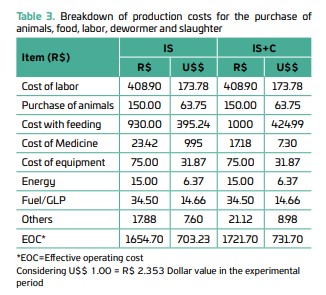Evaluation of production systems and economic analysis of baby goats raised in the semiarid region of Paraíba
DOI :
https://doi.org/10.21708/avb.2021.15.2.9305Résumé
The objective of this study was to evaluate the performance and economic indicators of baby goats region submitted to different feeding systems in the Semiarid. A total of 30 baby goats of breed Parda Alpina × without defined racial pattern (SPRD) with initial weight of 3.35 kg ± 0.65 kg and final weight of 12.3 kg ± 0.5 kg were used, distributed in a completely randomized design in three breastfeeding systems with ten replicates each: traditional system (with natural breastfeeding), intensive breastfeeding system without concentrated supplementation, and intensive breastfeeding with concentrated supplementation. Goats submitted to the intensive artificial feeding system without concentrated supplementation showed a similar weight gain (121 g/day) when compared to the goats submitted to the system of suckling with concentrated supplementation (126 g/day). The highest income was provided by the animals submitted to the intensive system of suckling with concentrate. The gross margin for the two centenarians was positive, that is, revenues are higher than the effective operating cost, allowing us to conclude that the activity is paying off and will survive, at least in the short term. The diet of kids using concentrate provided better dry matter intake, greater weight gain and consequently presented better economic indicators.
Téléchargements

Téléchargements
Publié-e
Numéro
Rubrique
Licence
Autores que publicam na Acta Veterinaria Brasilica concordam com os seguintes termos: a) Autores mantém os direitos autorais e concedem à revista o direito de primeira publicação, com o trabalho simultaneamente licenciado sob a Licença Creative Commons Attribution que permite o compartilhamento do trabalho com reconhecimento da autoria e publicação inicial nesta revista. b) Autores têm autorização para assumir contratos adicionais separadamente, para distribuição não-exclusiva da versão do trabalho publicada nesta revista (ex.: publicar em repositório institucional ou como capítulo de livro), com reconhecimento de autoria e publicação inicial nesta revista. c) Autores têm permissão e são estimulados a publicar e distribuir seu trabalho online (ex.: em repositórios institucionais ou na sua página pessoal) a qualquer ponto antes ou durante o processo editorial, já que isso pode gerar alterações produtivas, bem como aumentar o impacto e a citação do trabalho publicado (Veja O Efeito do Acesso Livre).


 Esta obra está licenciada com uma Licença
Esta obra está licenciada com uma Licença 